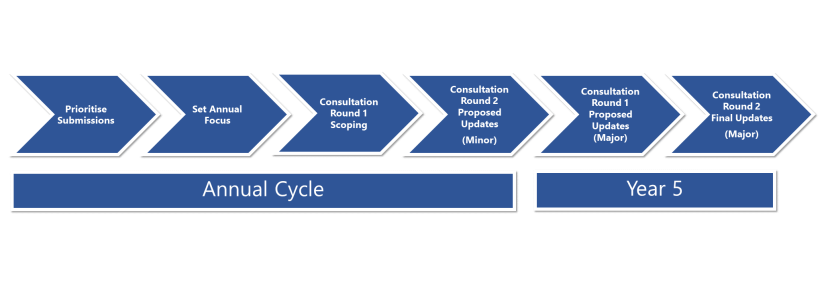The ABS rarely publishes statistics below the Unit Group level. Labour Force time series are produced at the Unit Group level. Changes to the time series outside of a scheduled major annual update can be prohibitively costly to backcast.
As a consequence, the most restrictive requirement for a minor, annual updates is that changes cannot affect the Unit Group time series data. This largely limits minor annual updates to Occupation level changes.
The changes that can be made to groups (which includes all levels of the ANZSCO hierarchy) are:
Text Only Changes
Text-only changes refer to changes in the descriptions and to selected attributes. Examples of selected attributes are tasks, specialisations, titles and alternative titles.
Textual change improves visibility and reflect contemporary terminology to enhance the utility of the classification. Changes to codes and changes that affect the scope of Unit Groups or above fall outside the definition of text-only. Text-only changes can be made during a minor annual update.
Skill Level Changes
Occupations are grouped by skill level and skill specialisation. When an Occupation group is deemed to contains jobs at different skill levels, the ABS will likely create a new Occupation.
Because predominant skill level defines each of ANZSCO’s Major Groups, the new Occupation may be classified in a different branch. In most cases, a skill level change will result in retirement or splitting of the original occupation.
As a result, skill level changes will often result in changes to the scope of Unit Groups and be stockpiled for an end-of-cycle major update.
Created
This is where a group becomes warrants separate identification within ANZSCO, such as emerging occupations. Creating new Occupations is possible during a minor annual update as long as the scope of the parent Unit Group remains unchanged. In some cases, the creation of new groups will need to be required at a Unit Group level or above. These changes will be applied during a major, end-of-cycle update.
Created from ‘Not Elsewhere Classified’
This is where Occupations are split from ‘Not Elsewhere Classified’ NEC categories. NEC occupation categories are often where emerging occupations will be included until they reach a size where they can be separately identified.
Since they are ‘residual’ categories, NECs are often less specific, less homogeneous and harder to describe. They are often excluded from the skilled visa program and time series analyses.
The ABS will perform a comprehensive review of all NECs every five-year cycle.
Retired
Where a group no longer describes a sufficient number of workers it may be retired, and the code discontinued. This commonly effects Occupations and less commonly Unit Groups.
The remaining workers would be coded to another relevant group, most likely a ‘Not Elsewhere Classified’ (NEC) category. This is done to ensure a manageable, balanced classification. If the retirement of an Occupation does not affect the scope of its parent Unit Group, the change can be implemented during an annual minor update.
Split, retiring the original code
This is where the original group and code is retired and new groups and codes are created. In most cases, splitting with retirement occurs at the Occupation level. Splitting and retiring the original code is done to meet demand for increased detail.
If the new Occupation groups stay within the original Unit Group then the split can be made during a minor annual update.
Split, without retiring the original code
This is where groups are created within the same parent group without retiring the original category and code. Workers previously coded to the existing occupation are now coded to a new occupations within the same parent group. For example, of splitting without retirement is when a specialisation of an existing occupation is separately identified as a discrete occupation.
Occupation splits without retirement that do not affect the scope of the Unit Group can be made during a minor annual update.
Moved between Unit Groups
There are constraints on the number of codes that can fit within a given Unit Group. As a result, some Occupation groups may change codes and Unit Groups without any conceptual change. These changes will have no significant impact on time series data at the Unit Group level (apart from a change in code).



